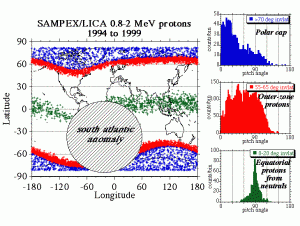The outer radiation belt as seen with protons: a new view with SAMPEX
We have used the LICA sensor on board SAMPEX to create a picture of the low-altitude environment of ~1 MeV protons. The low-Earth orbit of SAMPEX enables us to detect protons from a number of sources. The LICA sensor has an extremely low efficiency for coincidence measurements of protons (much less than 0.1%). Nevertheless, with many years of accumulation time we have sufficient counts of these populations in order to see how they vary in space and time.
We highlight 3 distinct populations in the left-most figure of geographic latitude versus longitude: (1) protons near the geomagnetic equator that arrive at low altitudes as energetic neutrals from the outer radiation belt (green symbols); (2) protons in the outer radiation belt (red symbols); (3) protons in the polar caps from small solar particle events (blue symbols). Not only do the geomagnetic distributions distinguish these 3 populations from one another, but we also find that their pitch angle distributions shed further light on their origin and ultimate fate.
The right-most 3 figures show the pitch angle distributions of the 3 populations. We observe the equatorial protons (green histogram) at their mirror points. These protons are the trapped remnant of a continual flux of energetic neutral hydrogen that originates at higher altitudes in the outer radiation belt (Mazur et al., GRL, 25, 849-852, 1998). During their drift around the Earth these protons mirror deep within the atmosphere in the SAA and become lost. Some of the outer-zone protons (red histogram) are locally mirroring, while we observe others within the bounce loss cone. Finally, the blue histogram shows interplanetary protons that precipitate into the atmosphere within the polar caps.
We will study the outer-zone protons in more detail. Scholer et al. (JGR, 84, 79-85, 1979) reported outer-zone proton and alpha precipitation in the geomagnetic storm of 26 March 1976. With well over fifty cases of ion precipitation during geomagnetic storms observed with SAMPEX, we can now examine the detailed behavior of this particular population including such questions as how the precipitation varies with local time. Given the well-studied dynamics of the outer-zone electrons near ~1 MeV, the outer-zone protons offer another picture of how outer radiation belt particles are scattered and lost into the atmosphere.
Contributed by Joe Mazur, The Aerospace Corporation
«Return to the Results page
